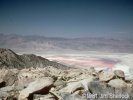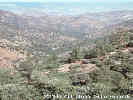 Carl Purpus, Plant
Collector in Western America
Carl Purpus, Plant
Collector in Western America 
Barbara Ertter
University and Jepson
Herbaria
University of California
Berkeley, CA 94720






Topics in this Article: Literature Cited | REPRINTED FROM
… The Plant Biology of Eastern University of California
| Literature Cited: Locations: Farewell Gap. Hockett Meadows. Little Kern River. Middle Tule River. Mount Moses.
Purpus returned to the Sierra Nevada the following summer. His description
of his travels in 1896 [Purpus, 1896b] are somewhat less effusive, but more
descriptive of his actual route. He left Springville with a guide and several
pack animals in June and headed up the Middle Fork of the Tule River. They were
forced to camp until the middle of June waiting for the snow in the passes to
recede. He explored Mt. Moses and camped for 10 days in Hockett Meadows,
ascending the surrounding peaks, before continuing to the headwaters of the
Little Kern River. Many of his collections from this region are from Farewell
Gap, between the Kern and Kaweah drainages.
|
|  Trout Meadows, southern Sierra Nevada, California.
Trout Meadows, southern Sierra Nevada, California.
 Owens Lake from Olancha Peak, California.
Owens Lake from Olancha Peak, California.
Locations: Golden Trout Creek. Lyon Meadows. Monachy Meadows. Olancha Peak. Trout Meadows.
After a fortnight they headed down the Little Kern River to Lyon Meadows and
Trout Meadows, where they were caught in a violent hail storm. They crossed the
swollen river and proceeded up Golden Trout Creek, which Purpus called Whitney
Creek. Purpus refers to his next major camp and collecting site as "Monatchy
Meadows", but because he describes Olancha Peak to the southeast he was
apparently in Strawberry Meadow instead. He climbed Olancha Peak and described
the "… fantastic view overlooking the Owens River Valley with the deep blue Owens
River Lake." One of the plants he collected on Olancha Peak was a Monardella
that remained undescribed for over 90 years.
|
| Locations: Corcoran Peak. Coso Mountains. Cottonwood Creek Canyon. Purpus then descended into the
Owens Valley via Cottonwood Creek Canyon.
He collected around the alkali lake and surrounding desert, including an
excursion to the Coso Mountains. After several weeks in the valley, they began
their return trip. Enroute Purpus climbed Corcoran Peak, or "Old Mount Whitney",
and collected again around Farewell Gap and the Little Kern River.
|
|  Chamaebatiaria millefolium.
Chamaebatiaria millefolium.  Joshua Tree Woodland near Walker Pass.
Joshua Tree Woodland near Walker Pass. Other Articles: Purpus' 1896 Trip: 0250 Locations: Walker Pass. Letters: 10/27/1896
He returned to Springville at the beginning of September, but set out soon
after to return to Cottonwood Creek Canyon. To avoid the danger of snow storms
in the high mountains at this late season, he took a southern route over Walker
Pass. His goal was to collect seeds of Chamaebatiaria millefolium, which he
considered one of the loveliest shrubs in the eastern Sierra Nevada: "A more
beautiful shrub than this magnificent one cannot be imagined." On his return
trip he again explored the Coso Mountains, although most of the annuals were long
past. He arrived back in Springville in late October, after a journey he said
was "… blessed with perfect weather".
|
| Literature Cited: Other Articles: Southern Sierra, Argus and Madurango Ranges (1897): 0020 Locations: Deer Creek. Walker Pass. White River. Letters: 10/27/1896
In early May of 1897 he and his companion again headed for Walker Pass, this
time with a wagon [Purpus, 1897]. After camping at Deer Creek, they passed by
White River: "Gold mining had once been attempted here, but the venture was not
very productive". They camped at a spring in Linns Valley and then followed an
"excellent, well-shaded trail [that] led rather steeply uphill to Greenhorn
Pass", stopping partway up at Cedar Creek, "… a small, crystal-clear mountain
spring". He noted Garrya laden with fruit, "… called 'quinine tree' because all
of its parts contain a terribly bitter substance".
|
|  Erskine Creek drainage, Piute Mountains, California.
Erskine Creek drainage, Piute Mountains, California.
Other Articles: Southern Sierra, Argus and Madurango Ranges (1897): 0060 Locations: Erskine Creek. Greenhorn Pass. Hot Spring Valley. Isabella Lake. Lookout Peak.
On the eastern side of Greenhorn Pass, Purpus was treated to "… a beautiful
view of the green valley where the North and South Forks of the Kern River meet,
bounded by steep, rather bare, rocky mountains," now the site of Isabella Lake.
They crossed the Kern River and headed south to Hot Spring Valley. His goal was
the Piute ("Pah-Ute") Mountains, where he planned to spend a few weeks
botanizing. They proceeded up Erskine Creek and camped on L. B. Hobson's ranch
at the foot of what he calls Piute Peak, which from all indications is probably
present-day Lookout Peak.
|
| Locations: Piute Mtns. Letters: 5/23/1897
Among the new species he discovered in the Piute Mountains are the lovely
Delphinium purpusii Brandeg. and Astragalus subvestitus (Jepson) Barneby. In a
letter dated May 23, 1897, he describes "… an other Echeveria, which is alltogether
different from E. purpusii it grows on Granit[e] and limestone rocks and has
smaller leaves and stroh colored flowers"; this is the plant that has recently
been described as Dudleya calcicola Bartel & Shevock. His published travelogue
mentions a Cupressus he did not recognize, an obvious reference to the endemic
Piute Cypress.
|
|
Other Articles: Southern Sierra, Argus and Madurango Ranges (1897): 0180 Locations: Indian Wells.
Purpus left the Piute Mountains mid-June and proceeded through the valley
of the South Fork of the Kern River to Walker Pass. He describes the stand of
Joshua trees that spans the pass, which "… presented a very interesting, remarkable
sight, and gave the landscape a southern character." After camping at a
willow-shaded spring on the east slope, they headed to Indian Wells. He writes:
|
|
Other Articles: Southern Sierra, Argus and Madurango Ranges (1897): 0200
| To the left rose the wonderfully sculptured peaks of the Sierra, bare or sparsely forested with Pinus monophylla. To the right were the dark, volcanic ridges of the El Paso Range, and to the northeast, the bare peaks of the Argus Mountains and part of the Coso Mountains. Between the reddish gray mountains rose a dark red to black extinct crater, very characteristic of these mountains. The places where lava had flowed down the mountain slopes and poured forth onto the plains were very interesting. It looked as if such areas were shaded by clouds while the lighter parts of the mountains were in the full glare of the sun.
| Literature Cited: Locations: Argus Range. Maturango Peak. Mountain Springs Canyon. Salt Wells.
From Indian Wells they crossed the desert to the east, arriving that
evening, tired and thirsty, at Salt Wells. The next morning they continued north
to the Argus Range. Purpus explored the Argus Range until the end of June,
based first at the mouth of Mountain Spring Canyon and then at the foot of Argus
Peak. He also visited Maturango Peak, admiring the view east to the Panamint
Mountains. According to Purpus [1897], the Argus Range derived its name from the
numerous scattered shrubs, which give the slopes the appearance of having a
hundred eyes.
|
| On his return trip,
Purpus backtracked to the Piute Mountains, where he
collected for two more weeks. He then returned to Springville for a month-long
recuperation, after which he collected around the headwaters of the Kaweah,
Little Kern, and Middle Tule rivers until late September. In a letter sent from
Broder's Cabin in Mineral King (8 September, 1897), he writes:
|
| Locations: Broder's Cabin, Mineral King. Letters: 9/8/1897 | I had a very bad experience with Capt. Gale who is superintendent of the Park, as he was about ready to turn me and my man, who helps me collecting, out of the park, although I had a letter of introduction to him by the General from last year.
| It sounds as if
Captain Gale were more effective in barring botanists than
sheep from Sequoia Park, based on a letter from the previous year (19 December,
1896):
|
|  Sheep near Stampede Reservoir, California.
Sheep near Stampede Reservoir, California.
Letters: 12/19/1896 | It is of no use to go a third time into these Mountains, because I think I have collected almost everything worth collecting and because the feed in that big sheep pasture--the Sequoia park not included--is getting so scarce, that it is quite impossible to stay in one place for more than three or four days. It was worse this summer, than I ever have seen it before and I would not have been surprised to see some of those Basks with their flocks on the very top of Mt. Whitney; They pretty near reached the top of Old Mt. Whitney though, and when they had cleanded [sic] out every grass spot in the so called reservation - that name is nothing but a mockery, the[y] went into the Sequoia park allthough protected by soldiers of the U. St. Army.
| Purpus could be very
outspoken in his letters, and overgrazing by sheep was
certain to trigger an outburst (4 December, 1895):
|
| Letters: 12/4/1896
| Yes, those sheepmen and their flocks ought to be exterminated unter all circumstances, they [sic] sooner, they better. It is not only a pity, no it is a shame and a sin to see those nasty sheep ruining that wonderful Mountain region and it's flora. It was more, than I could stand, and it made me so mad, that I more than a dozen times a day said to my guide "I could kill every one of those sheep", although I never kill animals except rattlesnakes! . . .
| Letters: 12/4/1896
The only group who received equal condemnation were "the woodchoppers" in the
Sequoia region (14 September, 1895): "It is simply an outrage and I got so mad
about it that I felt as if I ought to pick up a club an[d] knocking them down."
| |
[Previous Page] [Next Page] | |
| [Published Biographies] [Travelogues and Articles] [Letters] [Plant Lists and Bibliography] [Site Administration] | | Date and time this article was prepared: 6/7/2002 7:32:33 PM |